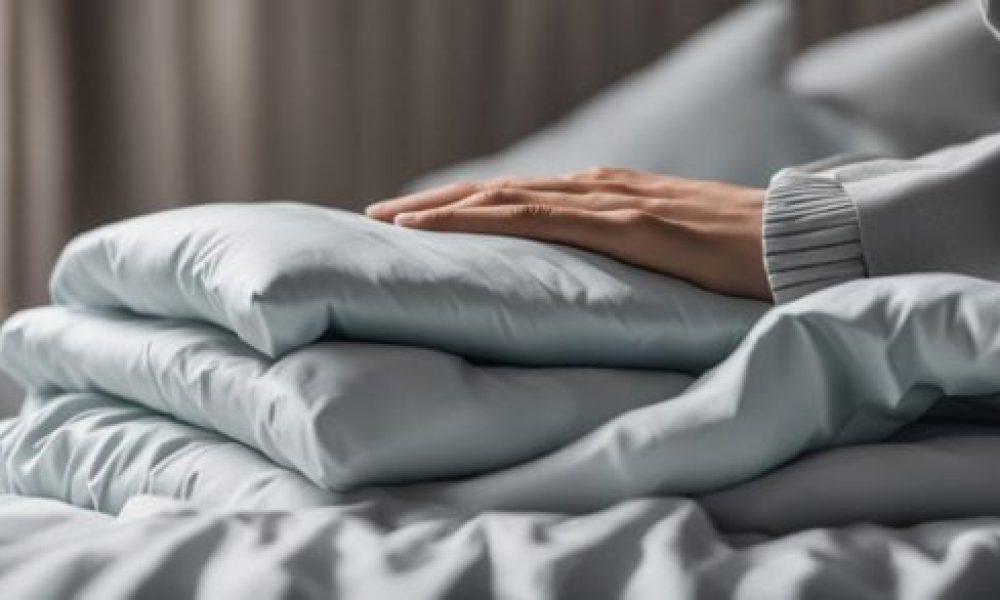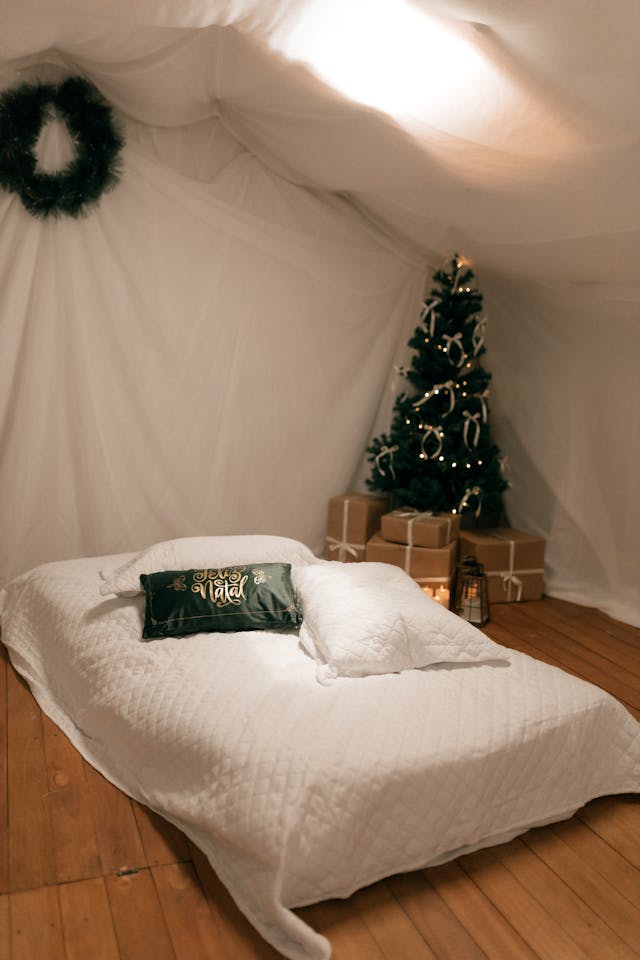Can Bedding Be Donated?
Wondering, can bedding be donated when it’s time to refresh your sleep setup? The answer is yes—and it’s one of the easiest ways to declutter sustainably while helping someone in need. Below you’ll find exactly where to donate, what’s accepted, and eco-conscious alternatives like textile recycling and upcycling.
Key Takeaways: Can Bedding Be Donated
- Yes, can bedding be donated—if it’s clean, undamaged, and odor-free.
- Great options include local shelters, charities, and online reuse communities.
- If donation isn’t possible, choose textile recycling or DIY repurposing.
- Donating supports sustainable, eco-conscious, and organic bedding practices.
- Use our checklist to ensure your items meet acceptance criteria.
Why Donate Bedding?
Answer first: Donating keeps usable textiles out of landfills and quickly gets essentials to people in need. If you’ve wondered Can Bedding Be Donated locally, the short answer is yes—most communities have options.
Americans send millions of tons of textiles to landfills each year; in 2018 alone, the U.S. landfilled roughly 11.3 million tons of textiles. Sheets and pillowcases are specifically tracked in the data, underscoring the value of reuse and recycling. EPA textile waste data
Beyond the environmental benefits, your donation supports local shelters and transitional programs that depend on steady supplies of linens. It also fosters a culture of generosity at home while aligning with sustainable bedding and eco-conscious bedding values.
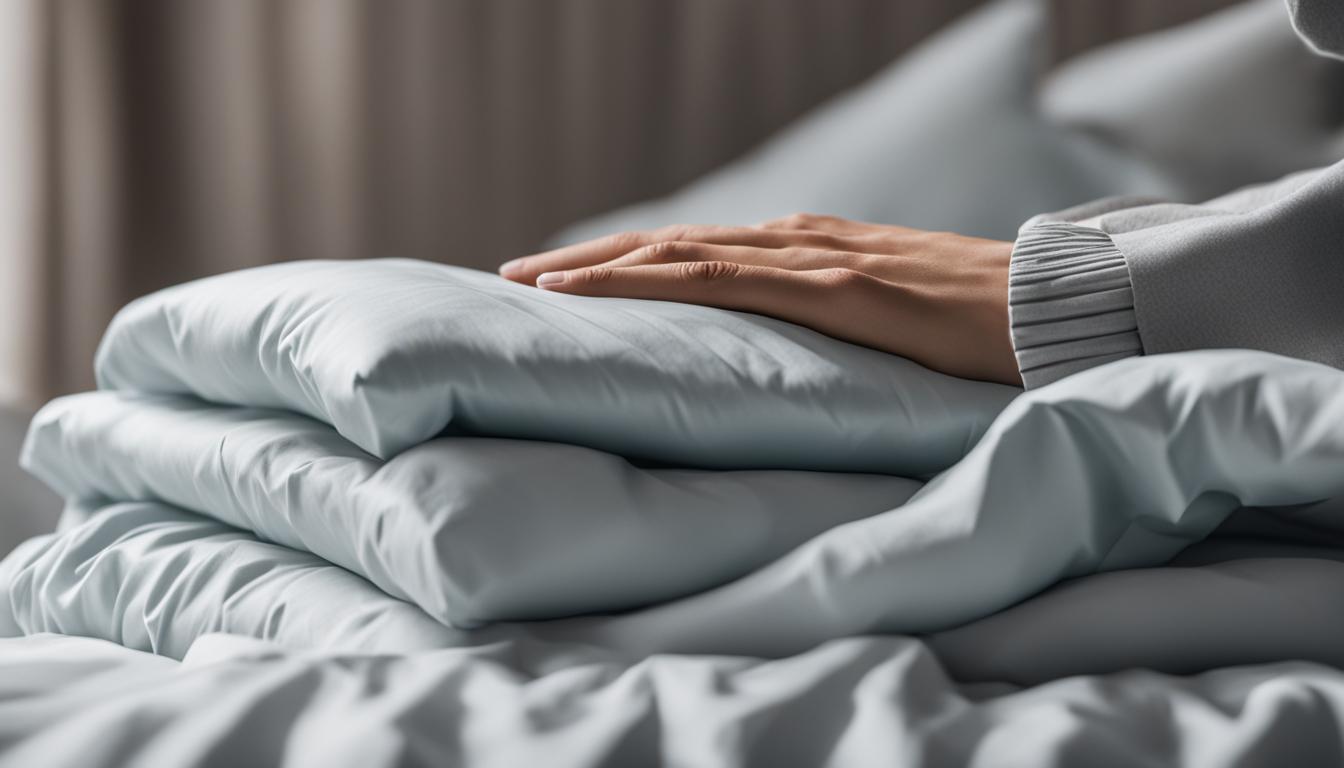
Criteria for Donating Bedding
Answer first: Most organizations accept gently used bedding that’s freshly washed and fully usable. Use this quick checklist before you go and share it when someone asks, “Can Bedding Be Donated if it’s lightly used?”
| Criteria | Details |
|---|---|
| Condition | Free of stains, tears, holes, or heavy wear. |
| Cleanliness | Freshly laundered, dry, and odor-free (no smoke or pet odors). |
| Type Accepted | Some sites specify sizes (twin/queen) or materials—check first. |
| Usability | Must still offer warmth, coverage, and comfort. |
Following these criteria preserves recipients’ dignity and helps charities avoid disposal costs. For more on selecting durable, long-lasting linens that donate well later, see investing in quality bedding (internal).
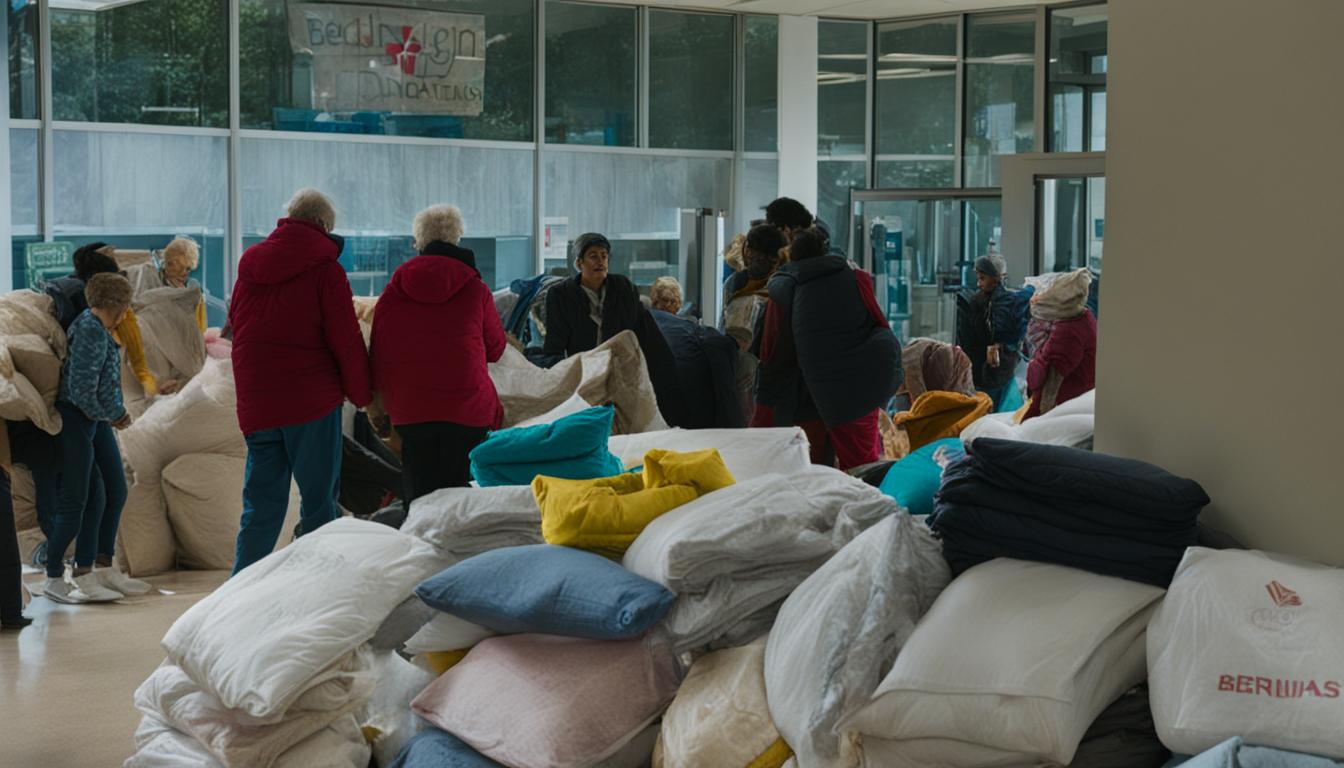
Where Can You Donate Bedding?
1) Local Shelters & Community Programs
Answer first: Start local. Homeless shelters, women’s shelters, and transitional housing programs frequently accept gently used bedding—but needs vary, so call first. When neighbors ask, “Can Bedding Be Donated to a shelter?” the best practice is to confirm sizes and quantities ahead of time.
Donations here serve people with immediate needs, and demand typically rises in colder months. If your first choice can’t accept bedding due to storage or hygiene policies, ask for a referral to a partner agency.
2) Charities & Drives
Answer first: Community drives and regional nonprofits organize seasonal blanket and sheet collections. Search your city’s events page or social channels for “bedding drive” and you’ll usually find straightforward answers to Can Bedding Be Donated in bulk.
Many organizations coordinate logistics and can handle bulk donations from apartment buildings or employers. If you manage a drive, list accepted sizes (e.g., twin for shelters with bunks) and provide sealed bags for sanitary transport.
3) Online Reuse Platforms
Answer first: If local organizations can’t accept your items, post them for free to neighbors so they’re reused immediately. For many households asking “Can Bedding Be Donated nearby?”, online reuse groups provide the fastest yes.
- Freecycle — reuse community that keeps goods out of landfills.
Tips: include clear photos, sizes, and fabric types (cotton, linen, bamboo). Meet in public places and confirm pickup details beforehand.
Eco-Friendly vs. Conventional Bedding Disposal
Answer first: Donation beats disposal for both environmental and social impact. When donating bedding isn’t an option, opt for textile recycling to divert fibers from landfills. If you’re weighing “Can Bedding Be Donated or should I recycle?” choose donation first when items are clean and usable.
Traditional disposal adds to landfill mass, where synthetics may persist for decades. Choosing to donate or recycle supports a circular economy and reduces the need for new resource-intensive production—especially important if you’re trying to prioritize organic bedding or sustainable bedding in your home.
For perspective on U.S. textile flows (including towels, sheets, and pillowcases), see the EPA’s latest summary. EPA textile waste data
How to Donate Bedding Successfully
Answer first: A well-prepped, well-matched donation gets accepted faster and used longer. Share these steps whenever someone asks “Can Bedding Be Donated and what prep is required?”
- Prep: Wash, fully dry, and neatly fold. Remove pet hair and lint.
- Match: Call ahead to confirm sizes and materials accepted; ask about pillows and mattress pads (often restricted).
- Deliver: Drop off during listed hours or arrange pickup. Request a receipt if itemizing deductions.
Upgrading after you donate? Explore breathable, moisture-managing options in temperature-regulating bedding (internal) and learn the differences in fitted vs. flat sheets (internal) before you buy.
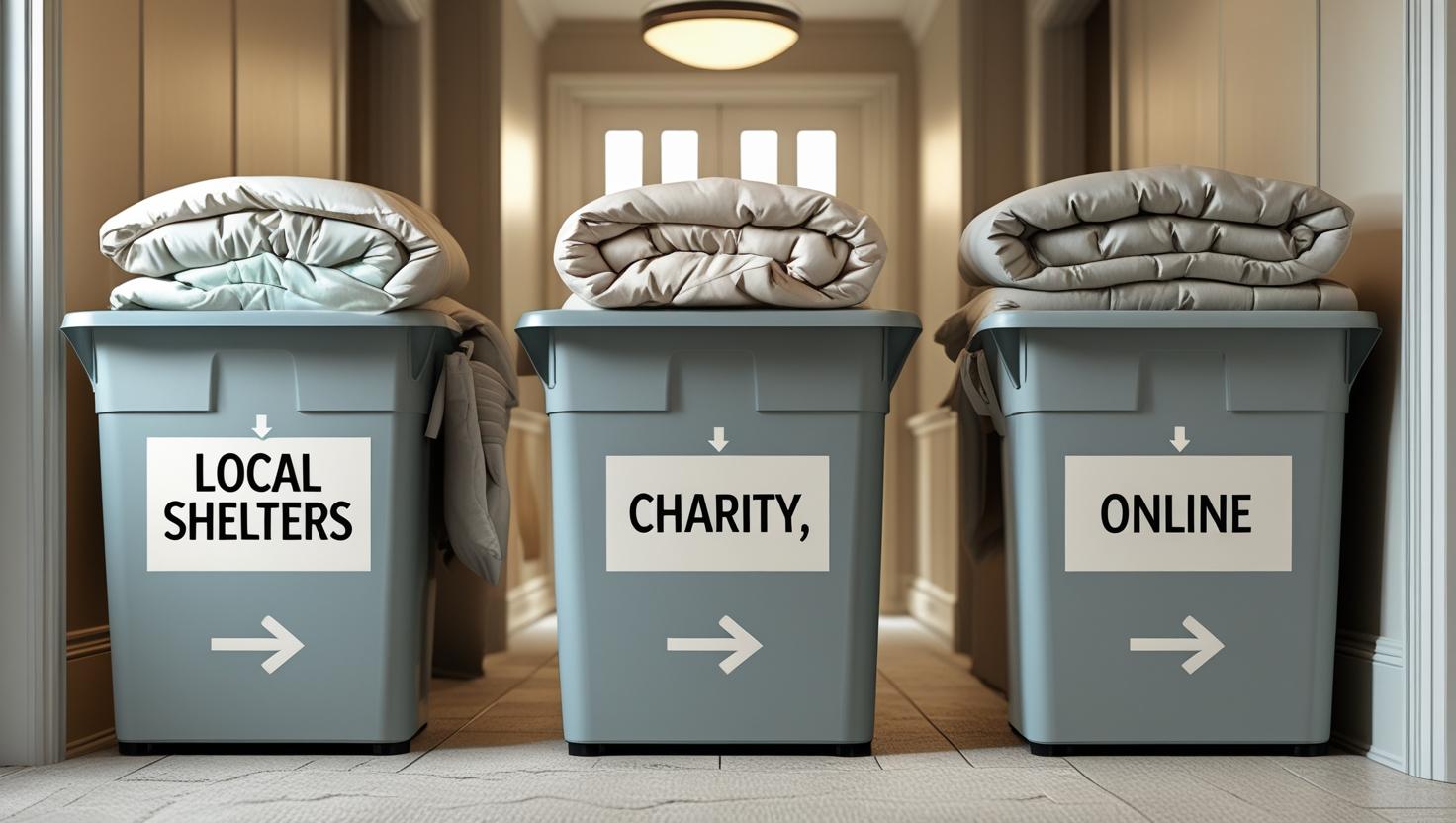
Recycling or Repurposing If Donation Isn’t Possible
Answer first: If items are stained, torn, or otherwise non-donation-ready, go with textile recycling or upcycling to keep fibers in use. If you’re unsure whether Can Bedding Be Donated in your area due to restrictions, default to a textile drop-off.
- Earth911 — use the locator to find nearby textile drop-offs and municipal programs.
- Bye Bye Mattress — state programs and drop-off locations (mattress recycling) with broader guidance.
Before recycling, remove hardware (zippers, snaps) that could jam machinery. Some centers accept pillows and pads; confirm locally.
DIY Upcycling Ideas for Old Bedding
- Turn sheets into washable cleaning cloths or pet crate liners.
- Sew thicker blankets into cushion covers, drawer liners, or tote bag interiors.
- Layer worn bedding into no-sew pet beds or picnic quilts.
- Make simple curtains, garment bags, or moving-day furniture wraps.
- Craft reusable gift bags or produce bags to cut paper and plastic waste.
Allergies at home? Prioritize fabrics that resist dust mites and mold. See bedding & allergies: key facts (internal).
Buyer’s Guide: What to Know Before You Donate
Answer first: Cleanliness and usability drive acceptance. Size and material preferences vary by organization, so check first to save a trip. If you’ve been Googling “Can Bedding Be Donated with minor wear?”, most places say yes when items are freshly laundered and intact.
- What’s commonly accepted: Sheets, pillowcases, blankets, and many comforters.
- Sometimes restricted: Pillows, mattress pads, down-filled items (policies vary).
- Hygiene matters: Items must be freshly washed, dry, and odor-free.
- Label sizes: Twin is often most requested for shelters; bag and label each set.
When refreshing your linen closet, consider materials with a lighter footprint and strong durability so they’ll be donation-ready later. Explore benefits of organic bedding (internal).
Sustainable Materials & Certifications (Quick Primer)
Answer first: Choosing responsibly made textiles today makes tomorrow’s donation or reuse more likely. It also makes the answer to “Can Bedding Be Donated after years of use?” more likely to be yes.
- Popular sustainable fibers: Organic cotton, linen, hemp, TENCEL™ lyocell, and responsibly sourced wool.
- What to look for: Certifications such as GOTS (organic), OEKO-TEX® (harmful substances), or FSC (packaging/paper).
- Care for longevity: Wash on gentle, avoid high heat, and rotate sets to reduce wear.
Material deep dives: bedding material choices (internal) and thread count & quality (internal).
Case Study: Small Actions, Big Impact
Answer first: A simple apartment-wide linen drive can supply dozens of clean sheet sets to a shelter in a single weekend. A clear flyer that answers “Can Bedding Be Donated and where?” boosts participation dramatically.
Coordinate by posting a clear list (accepted sizes/fabrics), placing sealed donation bins in high-traffic areas, and scheduling a single drop-off. Photograph the items for accountability (and tax records if applicable) and share final outcomes with participants to encourage future drives.
FAQ
- Can bedding be donated if it’s used?
- Yes—if it’s clean, undamaged, and free of odors. Many shelters will accept gently used sheets and blankets.
- Can Bedding Be Donated if it has minor pilling?
- Light cosmetic wear is usually fine. Heavy wear, tears, or stains are common reasons for rejection—choose recycling instead.
- What items are usually accepted?
- Sheets, pillowcases, blankets, and some comforters are common. Policies on pillows and mattress pads vary—call first.
- What if my bedding is too worn to donate?
- Recycle it using textile drop-offs (see Earth911) or repurpose into rags and pet bedding. For mattress recycling programs, see Bye Bye Mattress.
- Where else can I donate locally?
- Check churches, mutual aid groups, foster networks, and reuse platforms like Freecycle. Always verify current needs.
- How should I package donations?
- Wash and dry fully. Fold and bag sets together, label size (e.g., “Twin Sheet Set”) to streamline intake.
- Can Bedding Be Donated during seasonal drives only?
- No—many organizations accept year-round. Seasonal drives increase demand, but well-prepped linens are helpful anytime.
- What’s the best fabric if I want a longer-lasting set to eventually donate?
- High-quality organic cotton or linen tends to wear well with proper care. See organic bedding benefits and investing in quality bedding (internal).
Final Thoughts: Can Bedding Be Donated
Can bedding be donated? Absolutely. With a little prep, you can give clean, cozy linens a meaningful second life—reducing waste and supporting your community. And if donation isn’t an option, recycling and upcycling keep fibers in use. For more guidance on sustainable bedding choices and long-lasting linens, explore Cozy Bed Quarters’ resources throughout this guide.

